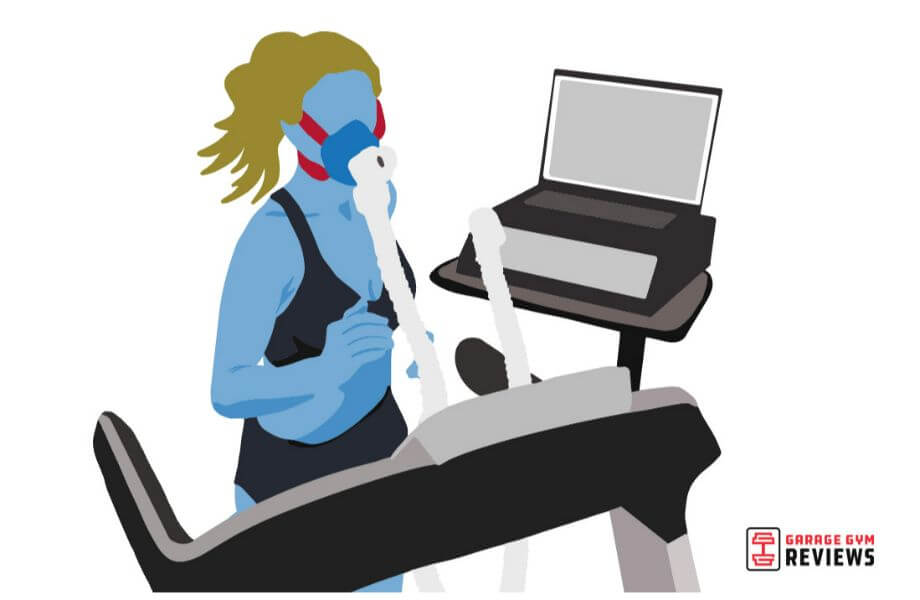We test and review fitness products based on an independent, multi-point methodology. If you use our links to purchase something, we may earn a commission. Read our disclosures.
In our complete guide, learn how to use our VO2 max calculator, what the VO2 max metric means, and how to improve it.
In this guide to VO2 max, Dr. Luis Javier Peña-Hernández, MD, FCCP, a lung health specialist on our GGR expert panel, helps us answer the question “What is VO2 max?” and explore how to measure and utilize this metric to enhance fitness performance.

Instructions for this VO2max Calculator
What you need: A walking location, stopwatch
- Female
- Male
- Pounds
- Kilograms
There’s a funny thing that happens in the fitness world: As people become more involved and their fitness level improves, they tend to immerse themselves more into the various metrics that measure fitness. Take the rapid growth in popularity of fitness trackers, for example. People love fitness trackers because they provide concrete numbers that serve as benchmarks and predictors of fitness.
Metrics like maximal heart rate, average resting heart rate, basal metabolic rate, body weight, and body composition help people understand their health, fitness, and performance.
But what about other, more obscure metrics, such as blood oxygen saturation or VO2 max? Are these as important or informative as a simple measure like pulse?
Medical disclaimer: This article is intended for educational and informational purposes only. It is not intended as a substitute for medical advice. For health advice, contact a licensed healthcare provider.
First Things First: What Is VO2 Max?
Put simply, VO2 max is the maximum oxygen consumption a person can achieve during exercise, Dr. Peña-Hernández says.
“It’s an indirect measurement of the ability of a person to tolerate a workload during exercise,” he continues, explaining that VO2 max “reflects the ability of the heart to generate an adequate cardiac output or blood flow per minute, along with the ability of your lungs to transport oxygen to the blood and your muscles to effectively use the oxygen to burn calories during exercise.”
Said differently—and without scaring you away with medical terminology—VO2 max is an indicator of overall cardiorespiratory fitness (which includes heart, lungs, and blood vessels) and metabolic health.
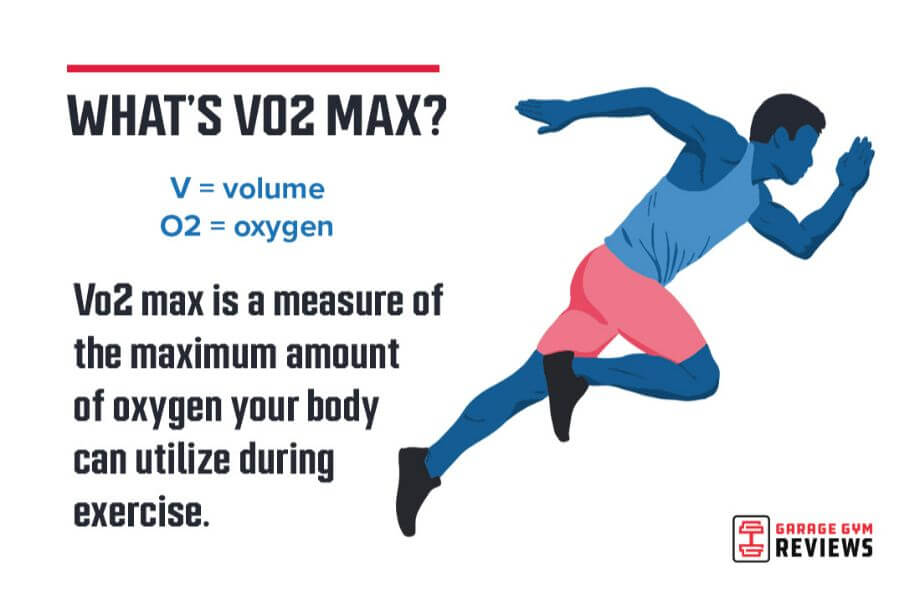
How To Measure VO2 Max
Typically, VO2 max is measured in a lab setting, and that’s where you’ll get the most accurate and reliable results. Precise VO2 max testing isn’t something you can replicate at home, no matter how fancy you think your WHOOP Strap is.
To measure maximal oxygen consumption, sports medicine professionals administer a cardiopulmonary exercise test that monitors the oxygen (O2) and carbon dioxide (CO2) content of inhaled and exhaled air during exercise, Dr. Peña-Hernández explains.
The results of this type of test are typically presented as “VO2 max values” and are measured in milliliters of oxygen consumed per minute per kilogram of bodyweight. This is written as “mL/kg/min.”
Although at-home VO2 max testing isn’t as accurate as what you’d get in a lab, there are some simple equations that can give you a good idea of where your VO2 max values lie. Below, our VO2 max calculator can give you a baseline.
Wait, Why Does VO2 Max Even Matter? And Who Should Care?
Most people probably don’t need to care about their maximal oxygen uptake, Dr. Peña-Hernández says bluntly.
“VO2 max is useful during advanced medical evaluations for interventions like a heart transplant or a lung resection surgery during lung cancer treatment,” he says, and “In the setting of professional sports, it can be used as an objective measurement of the maximum cardiovascular performance of an elite athlete.”
To get your VO2 max measured, you’d go to a medical lab and wear an oxygen monitoring mask while doing a series of tests on a treadmill.
For the non-professional athlete, he says, VO2 max could be useful if indicated by a medical professional for the purpose of optimizing performance, but it might be costly and of limited value.
What that means for the everyday fitness enthusiast—yes, even those who race in endurance sports, recreationally compete in CrossFit, or otherwise push their limits regularly—VO2 max scores may not be worth your attention.
A better way to measure your aerobic fitness is to carefully log your endurance training, noting times, mileage, terrain, perceived exertion, heart rate, and exercise intensity. Doing so will allow you to identify patterns over time, without the need for lab testing.
VO2 Max As A Health Metric
There may be more value in looking at VO2 max as a health metric versus a fitness metric. As Dr. Peña-Hernández pointed out, VO2 max is helpful for medical professionals in evaluating their patients preceding and following certain types of procedures or treatments.
A meta-analysis of VO2 max literature reports that a modest increase in VO2 max—a rise of just one metabolic equivalent (MET, 3.5 mL/kg/min)—is associated with a 10 to 15% increase in survival of cardiovascular disease and all-cause mortality.
Still, though, there’s no need for the vast majority of people to engage in VO2 max testing, since there are many simpler ways to measure your cardiovascular health and endurance. Resting heart rate and your one-mile-run time are good examples.
What Is A Good VO2 Max?
This may come as a surprise, but there’s no defined “good” or “bad” VO2 max value, Dr. Peña-Hernández says.
There’s no volume of oxygen anyone “should” be able to consume, per se, rather a range of values that indicate a person is generally healthy.
That range is pretty large, according to Dr. Peña-Hernández: 25 to 85 mL/kg/min.
There are some averages, however, that you can use as a baseline to see where your fitness lies among other people your age and sex.
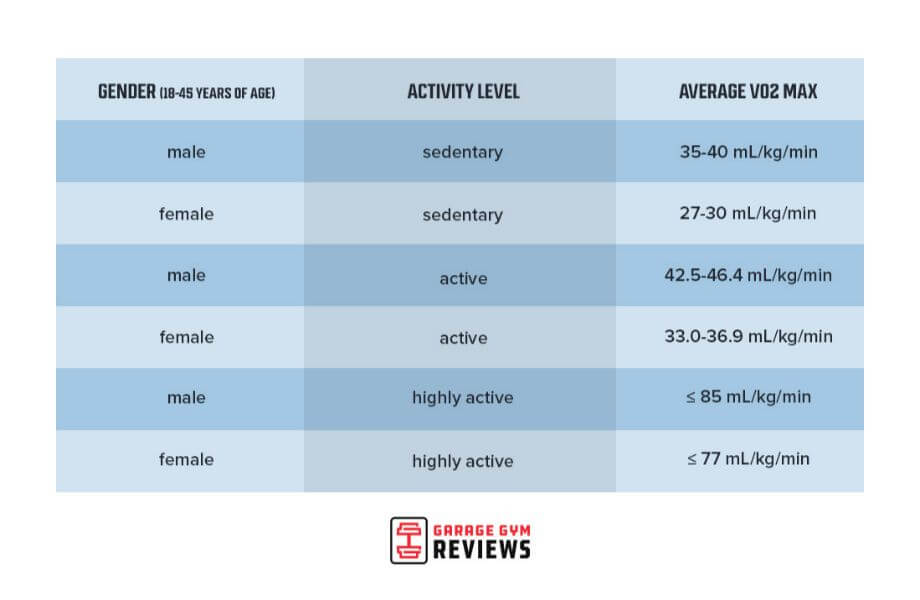
VO2 Max vs. Lactate Threshold
Lactate threshold, also called the anaerobic threshold, is defined as “the highest sustained intensity of exercise for which measurement of oxygen uptake can account for the entire energy requirement.”
At your anaerobic threshold, the rate of blood lactate accumulation is the same as its rate of disappearance, meaning your body is still able to use oxygen for energy demands.
But the moment you surpass your anaerobic threshold is the point at which your body switches energy systems, relying less on aerobic metabolism (oxygen) and more on anaerobic metabolism (lactate and glucose).
VO2 max is not the same thing as lactate threshold, although both are measurements of cardiorespiratory fitness.
The two measurements are related: Your lactate threshold occurs at a percentage of your VO2 max, which can range from 60 to 75% for the average fit person and up to 90% for elite athletes.
How To Increase Your VO2 Max
“Maintaining an active lifestyle, a healthy diet, and getting plenty of sleep would improve anyone’s cardiovascular endurance,” Dr. Peña-Hernández.
It really is that simple! (Not easy, of course, but simple.)
That said, if you’re really serious about increasing your aerobic capacity—with or without concrete VO2 max measures—the answer is high-intensity cardio training.
Steady-state aerobic exercise won’t propel you to a higher VO2 max, but high-intensity interval training (HIIT) or any sort of training that involves repeated near-maximal or maximal effort, will.
To increase the amount of oxygen you can consume in a given amount of time, you’ll need to push yourself to and past your anaerobic threshold over and over again in the pursuit of improving your body’s ability to use oxygen for energy under high duress.
Bike Workout to Increase VO2 Max
Here’s a workout for cyclists that can increase aerobic endurance. You can do this on a stationary bike or a regular bike.
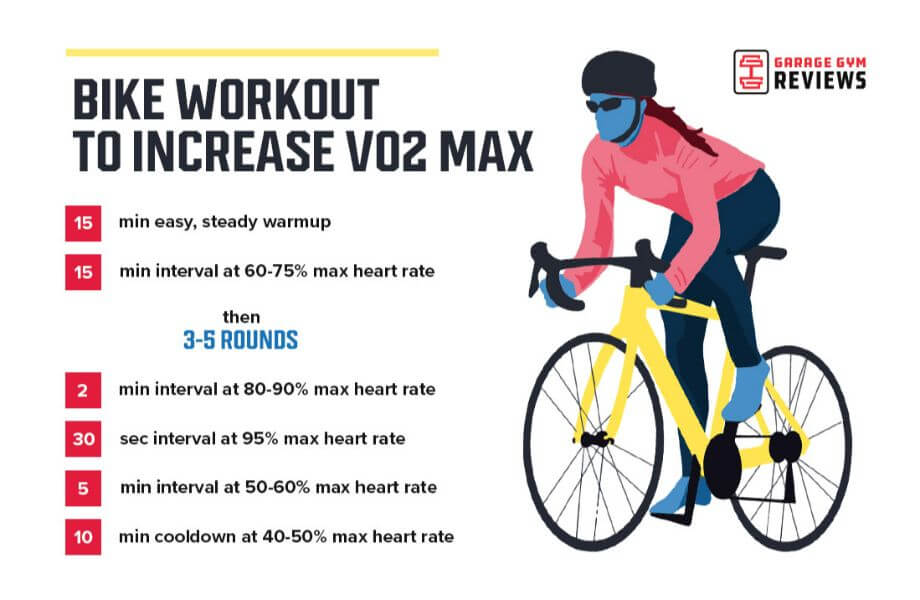
Treadmill Workout to Increase VO2 Max
This workout for runners will push your aerobic threshold over a period of 30 to 50 minutes (not including warmup and cooldown), and should bring you close to your lactate threshold several times.
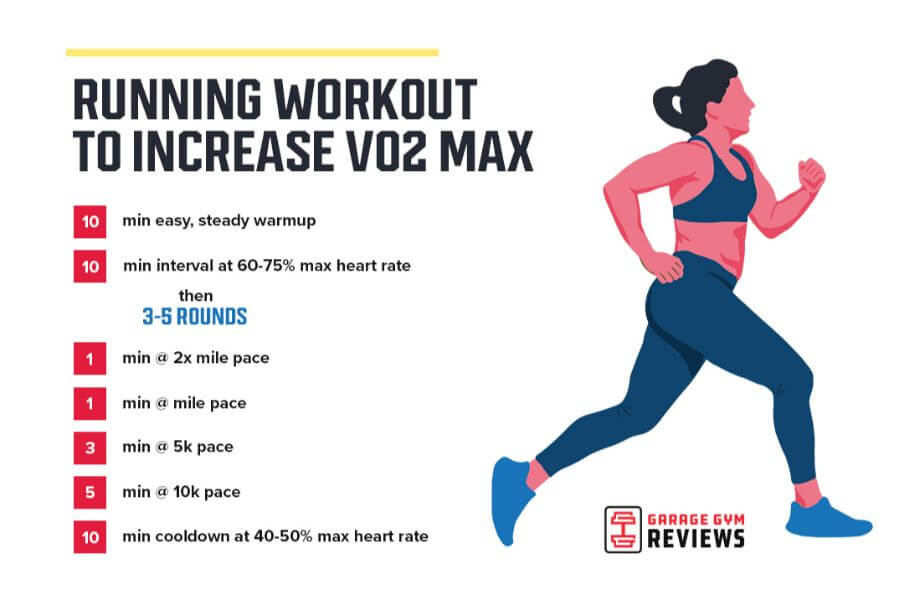
Trainer’s note: Approach this workout by using your fastest time for the listed pace. For example, if your 1-mile personal best is 7 minutes, you would run at a 7-minute mile pace for the one-minute interval. Likewise, if your 10K personal best is 60 minutes (about 10 minutes per mile), you’d run at a 10-minute mile pace for the 5-minute interval.
The Verdict: Does VO2 Max Matter?
As with many things in fitness, yes and no.
“The average recreational athlete would obtain a limited value from measuring VO2 max,” Dr. Peña-Hernández says, “as it would have to be measured consistently over time to evaluate a trend.”
However, it’s not a cost-effective method to monitor someone’s cardiovascular fitness, and it’s not as accurate on consumer fitness trackers as you might think.
“VO2 max is directly and indirectly influenced by several health, lifestyle, and demographic factors,” Dr. Peña-Hernández continues. “It’s directly related to cardiovascular health but meaningless as an isolated measurement without further evaluation of all the other components of the cardiopulmonary exercise test.”
In other words, wearing a simple heart rate monitor will do you more good than heading to a lab and paying to measure your maximal oxygen uptake.
References
Scribbans TD, Vecsey S, Hankinson PB, Foster WS, Gurd BJ. The Effect of Training Intensity on VO2max in Young Healthy Adults: A Meta-Regression and Meta-Analysis. Int J Exerc Sci. 2016;9(2):230-247. Published 2016 Apr 1.
Bacon AP, Carter RE, Ogle EA, Joyner MJ. VO2max trainability and high intensity interval training in humans: a meta-analysis. PLoS One. 2013;8(9):e73182. Published 2013 Sep 16. doi:10.1371/journal.pone.0073182
Svedahl K, MacIntosh BR. Anaerobic threshold: the concept and methods of measurement. Can J Appl Physiol. 2003;28(2):299-323. doi:10.1139/h03-023
Joyner MJ, Coyle EF. Endurance exercise performance: the physiology of champions. J Physiol. 2008;586(1):35-44. doi:10.1113/jphysiol.2007.143834
Helgerud J, Høydal K, Wang E, et al. Aerobic high-intensity intervals improve VO2max more than moderate training. Med Sci Sports Exerc. 2007;39(4):665-671. doi:10.1249/mss.0b013e3180304570
Further reading

Hip hinge exercises are just what you need to improve your weightlifting and your ability to perform everyday tasks. Check out our guide here! Read more

Exercise mats are for a variety of needs and uses, but all of these will help your gym be a quieter space. Here are the best soundproof exercise mats. Read more

Check out this Echelon Smart Connect Bike EX-3 review to learn about a compact bike that won’t break the bank. Read more

Can you lose weight on an exercise bike? We break down the answer—and bust some myths—here. Read more

